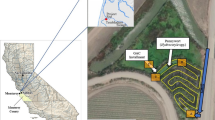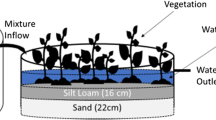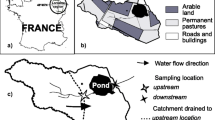Abstract
Agricultural use of organophosphate pesticides are responsible for surface water toxicity in California and has led to a number of impaired water body listings under section 303(d) of the Clean Water Act. Integrated passive-treatment systems can reduce pesticide loading in row crop runoff, but they are only partially effective for the more soluble organophosphates. The Landguard™ enzyme has been effectively proven as an on-farm management practice for the removal of chlorpyrifos and diazinon in furrow runoff, but it has not been used in larger-scale treatment because of concerns regarding the potential impact on in-stream macroinvertebrates after chronic use. A first-order agricultural creek was treated with the Landguard enzyme for 30 days approximately 450 m upstream of its intersection with the Salinas River. Toxicity and pesticide chemistry were measured in the creek during treatment as well as in the river both upstream and downstream of the creek input before and after treatment. Benthic macroinvertebrates were also surveyed in the river before and after enzyme treatment. Low concentrations of organophosphate pesticides were detected in the creek, but Landguard removed detected concentrations of chlorpyrifos. Toxicity detected in the creek was likely caused by pyrethroid pesticides, and no toxicity was detected in river samples. There were no differences in habitat or macroinvertebrate assemblages between upstream and downstream samples or between pre- and post-treatment samples. These results indicate that chronic treatment of the creek with Landguard enzyme had no impact on macroinvertebrate community structure in the river.




Similar content being viewed by others
References
Anderson BS et al (2003) Ecotoxicologic impacts of agricultural drain water in the Salinas River, California, USA. Environ Toxicol Chem 22:2375–2384
Anderson BS, Phillips BM, Hunt JW, Connor V, Richard N, Tjeerdema RS (2006) Identifying primary stressors impacting macroinvertebrates in the Salinas River (California, USA): relative effects of pesticides and suspended particles. Environ Pollut 141:402–408
Anderson BS, Phillips BM, Hunt JW, Largay B, Shihadeh R, Berretti M (2011) Pesticide and toxicity reduction using an integrated vegetated treatment system. Environ Toxicol Chem 30(5):1036–1043
Ankley GT, Dierkes JR, Jensen DA, Peterson GS (1991) Piperonyl butoxide as a tool in aquatic toxicological research with organophosphate insecticides. Ecotoxicol Environ Saf 21:266–274
Central Coast Regional Water Quality Control Board (2011) Total maximum daily loads for chlorpyrifos and diazinon in Lower Salinas River watershed in Monterey County, California. California Environmental Protection Agency and California Regional Water Quality Control Board Central Coast Region. Final Project Report For the May 4–5, 2011, Water Board Meeting
Gao Y, Truong YB, Cacioli P, Butler P, Kyratzis IL (2014) Bioremediation of pesticide contaminated water using an organophosphate degrading enzyme immobilized on nonwoven polyester textiles. Enzyme Microb Technol 54:38–44
Hunt JW et al (2003) Ambient toxicity due to chlorpyrifos and diazinon in a central California coastal watershed. Environ Monit Assess 82:83–112
Hunt JW et al (2008) Use of toxicity identification evaluations in determining the pesticide mitigation effectiveness of on-farm vegetated treatment systems. Environ Pollut 156:348–358
Maund SJ, Hamer MJ, Warinton JS, Kedwards TJ (1998) Aquatic ecotoxicology of the pyrethroid insecticide lambda-cyhalothrin: considerations for higher-tier aquatic risk assessment. Pestic Sci 54:408–417
Naqvi T, Warden AC, French N, Sugrue E, Carr PD, Jackson CJ et al (2014) A 5000-fold increase in the specificity of a bacterial phosphotriesterase for malathion through combinatorial active site mutagenesis. PLoS One 9(4):e94177
Ode PR (2007) Standard operating procedures for collecting macroinvertebrate samples and associated physical and chemical data for ambient bioassessments in California. California State Water Resources Control Board Surface Water Ambient Monitoring Program (SWAMP) Bioassessment SOP 001
Orica Watercare (2008) Landguard™ OP-A-Trial Data Overview. Orica Watercare Inc., Watkins
Phillips BM et al (2004) In situ water and sediment toxicity in an agricultural watershed. Environ Toxicol Chem 23:435–442
Siemann S, Yargeau T (1996) Hazard assessment of the insecticide dimethoate to aquatic organisms in the Sacramento-San Joaquin River System. California Department of Fish and Game, Environmental Services Division, Administrative Report 96–94
Song MY, Stark JD, Brown JJ (1997) Comparative toxicity of four insecticides, including imidacloprid and tebufeozide, to four aquatic arthropods. Environ Toxicol Chem 16:2494–2500
Starner K, Goh KS (2012) Detections of the neonicotinoid insecticide imidacloprid in surface waters of three agricultural regions of California, USA, 2010-2011. Bull Environ Contam Toxicol 88:316–321
United States Environmental Protection Agency (2000) Methods for measuring the toxicity and bioaccumulation of sediment-associated contaminants with freshwater invertebrates. USEPA/600/R-99/064. Office of Research and Development, Washington, DC
United States Environmental Protection Agency (2002) Methods for measuring acute toxicity of effluents and receiving water to freshwater and marine organisms. USEPA-821-R-02-012. Office of Research and Development, Washington, DC
United States Environmental Protection Agency (2010) National pollutant discharge elimination system test of significant toxicity technical document. USEPA 833-R-10-004. Office of Wastewater Management, Washington, DC
Weston D, Jackson C (2009) Use of engineered enzymes to identify organophosphate and pyrethroid-related toxicity in toxicity identification evaluations. Environ Sci Technol 43:5514–5520
Acknowledgments
Funding for this project was provided by the California Department of Pesticide Regulation Surface Water Protection Program. Terry Pritchard provided the Landguard dosing flume and controller. Gabe Rodriquez provided access to Quail Creek for the Landguard treatment system. Colin Scott of CSIRO provided the Landguard A900. Peter Meertens assisted with obtaining the low-threat permit to treat Quail Creek with Landguard. Sean Mundell provided field training and assistance with the bioassessment study. Pesticide chemistry was performed by the California Department of Wildlife’s Water Pollution Control Laboratory (Martice Velasquez). Macroinvertebrate samples were identified and analyzed by Chicago State University–Chico (Dan Pickard).
Author information
Authors and Affiliations
Corresponding author
Rights and permissions
About this article
Cite this article
Phillips, B.M., Anderson, B.S., Siegler, K. et al. The Effects of the Landguard™ A900 Enzyme on the Macroinvertebrate Community in the Salinas River, California, United States of America. Arch Environ Contam Toxicol 70, 231–240 (2016). https://doi.org/10.1007/s00244-015-0177-0
Received:
Accepted:
Published:
Issue Date:
DOI: https://doi.org/10.1007/s00244-015-0177-0




